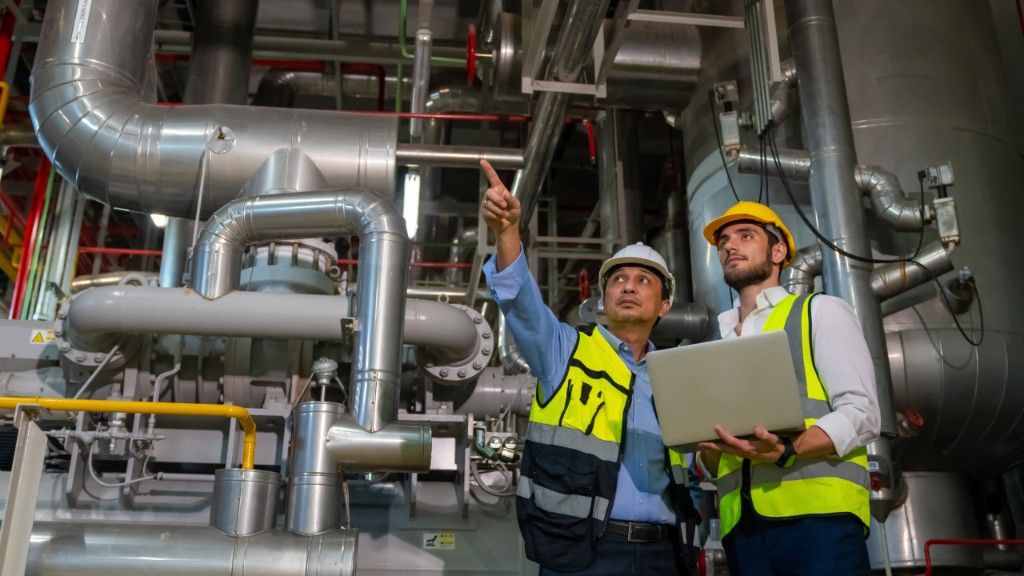CIO vs. CTO: Key Differences In Roles And Responsibilities
By Marco Franzoni • July 15, 2024

Introduction: CIO vs. CTO – Defining the Roles and Responsibilities
Overview of CIO and CTO Positions
In today's rapidly evolving tech landscape, the roles of the Chief Information Officer (CIO) and Chief Technology Officer (CTO) are often conflated, yet they serve distinct and crucial functions within a company. Both positions represent the highest technology executive positions within an organization, focusing on different aspects of technology management and strategy.
Importance of Understanding the Differences
Understanding the key differences between a CIO and a CTO is essential for business leaders, especially when developing effective technology strategies. While the CIO typically oversees the internal IT infrastructure and operations, ensuring alignment with business goals, the CTO is often more tech-focused, driving innovation and external customer-facing technologies.
Grasping these distinctions can help in making informed decisions about technology leadership, ultimately contributing to a company's success and innovation process. In this post, we will delve into the specific responsibilities, strategic importance, and evolving nature of both the CIO and CTO roles to provide a comprehensive understanding of their impact on business models and digital transformation efforts.

What does a CIO do? Common roles and responsibilities
Strategic Planning and IT Management
A Chief Information Officer (CIO) plays a pivotal role in strategic planning and IT management within an organization. As the highest technology executive position focusing on internal processes, the CIO is responsible for aligning the company's IT strategy with its business goals. This involves developing and overseeing comprehensive technology strategies that enhance the efficiency and effectiveness of the organization's operations.
Aligning IT with Business Goals
One of the primary responsibilities of a CIO is to ensure that the company's IT initiatives support and drive business objectives. This requires a deep understanding of both the business models and the technology landscape. The CIO works closely with other business leaders to integrate IT solutions that optimize internal processes and improve overall service delivery. This alignment is crucial for the company's success, particularly in a rapidly evolving digital transformation environment.
Ensuring Data Security and Compliance
In today's data-driven world, ensuring data security and compliance is a critical responsibility of the CIO. They are tasked with safeguarding the organization's information assets against cyber threats and ensuring compliance with relevant regulations. This involves implementing robust security measures, conducting regular audits, and staying abreast of the latest developments in information technology and cybersecurity. The CIO also oversees the development of policies and procedures that govern the use of technology within the organization, ensuring that all IT operations adhere to industry standards and best practices.
Responsibilities of a CIO
Overseeing IT Infrastructure
The CIO is primarily responsible for overseeing the organization's IT infrastructure. This involves managing the hardware, software, and networks that form the backbone of the company's operations. The CIO ensures that these systems are reliable, secure, and scalable to meet the growing needs of the business. This role is crucial in maintaining the company's products and services and supporting its overall business units.
Managing IT Budgets and Resources
Effective management of IT budgets and resources is another critical responsibility of the CIO. This includes allocating funds for various IT projects, negotiating with vendors, and ensuring that the company's IT investments deliver maximum value. The CIO must utilize capital efficiently to support both internal operations and external customer needs, balancing cost with the need for innovation and improvement.
Implementing New Technologies
Staying ahead of technological advancements is essential for a successful CIO. This involves implementing new technologies such as machine learning, big data, and software development tools to drive innovation and improve business processes. The CIO works hand in hand with other C-suite executives to develop policies and strategies that integrate these new technologies into the organization's operations, ensuring that the company remains competitive in the IT industry.
Understanding the Role of the Chief Technology Officer (CTO)
Focus on Innovation and Technology Development
The Chief Technology Officer (CTO) plays a crucial role in driving innovation and technology development within an organization. Unlike the CIO, who focuses on internal IT operations, the CTO is primarily concerned with leveraging new technologies to develop innovative products and services. This role involves staying ahead of technological trends, exploring new business models, and integrating cutting-edge technologies such as machine learning and big data into the company's strategic planning. The CTO's focus on innovation helps companies remain competitive in the rapidly evolving IT industry.
Leading Product Development and Engineering Teams
A significant responsibility of the CTO is to lead product development and engineering teams. This includes overseeing software development processes, guiding the creation of new products, and ensuring that the company's technical resources are utilized effectively. The CTO works closely with business units and other C-suite executives, such as the Chief Product Officer and Chief Digital Officer, to align technology initiatives with business goals. By fostering a collaborative environment, the CTO ensures that internal operations are streamlined and that external customers receive high-quality, innovative products.
What is Innovation Leadership in a CTO Role?
Driving Technological Advancements
Innovation leadership is a cornerstone of the Chief Technology Officer (CTO) role. A successful CTO is responsible for driving technological advancements within the organization. This involves not only identifying and implementing new technologies but also anticipating future trends that can provide a competitive edge. By focusing on areas such as software development, machine learning, and big data, the CTO ensures that the company remains at the forefront of technological innovation. This proactive approach to technology management is vital for developing new business models and improving processes across the organization.
Encouraging a Culture of Innovation
A crucial aspect of the CTO's responsibilities is fostering a culture of innovation within the company. This means creating an environment where creativity and experimentation are encouraged, and new ideas are valued. The CTO works hand in hand with other business units and C-suite executives, such as the Chief Digital Officer and Chief Product Officer, to integrate innovative thinking into the company's strategic planning. By promoting collaboration and open communication, the CTO helps build a dynamic, forward-thinking organization that continuously strives to innovate products and services for both internal operations and external customers.

Key Differences Between CIO and CTO Roles
Strategic vs. Operational Focus
The roles of Chief Information Officer (CIO) and Chief Technology Officer (CTO) differ significantly in their focus. A CIO typically has a strategic focus, responsible for aligning IT strategy with business goals and ensuring that the company’s internal processes run smoothly. They oversee the IT infrastructure, manage budgets, and implement policies to improve efficiency. On the other hand, a CTO is more operationally focused, concentrating on the development and implementation of new technologies. The CTO leads innovation efforts, drives software development, and ensures that the company's products meet market demands. This strategic vs. operational focus is a key distinction in understanding the different roles each position plays within an organization.
Internal vs. External Technology Focus
Another critical difference between a CIO and a CTO is their focus on internal versus external technologies. The CIO’s primary responsibility is managing the internal IT operations and ensuring that these systems support the business units effectively. This includes maintaining the IT infrastructure, ensuring data security, and improving internal processes. Conversely, the CTO focuses on external technologies, working to innovate products and services that enhance customer experiences and meet market needs. This role involves staying ahead of technological trends, integrating new technologies, and driving the development of new business models. The external focus of a CTO is crucial for maintaining the company's competitive edge in the tech industry.
How Do CIOs and CTOs Work Together and Collaborate?
Joint Initiatives for Business Growth
CIOs and CTOs often collaborate on joint initiatives that drive business growth and technological advancement. By leveraging their distinct areas of expertise, they can create comprehensive technology strategies that support both internal operations and external customer needs. For instance, while the CIO focuses on improving internal processes and IT infrastructure, the CTO can spearhead the development of innovative products and services. Together, they ensure that the company utilizes capital efficiently and stays ahead in the competitive IT industry. This collaboration is essential for developing new business models and integrating new technologies that enhance the company's products and services.
Balancing Responsibilities and Avoiding Overlaps
To collaborate effectively, CIOs and CTOs must balance their responsibilities and avoid overlaps in their roles. Clear communication and defined boundaries help in delineating their duties. The CIO typically handles internal technology management, focusing on strategic planning and aligning IT with business goals. Meanwhile, the CTO is responsible for external technology development, focusing on innovation and customer-facing technologies. By working hand in hand, they can ensure that both internal and external technological needs are met, leading to successful digital transformation and improved business outcomes. This balanced approach helps avoid redundancy and maximizes the efficiency of the company's technology initiatives.
Is a CTO the Same as a CIO?
Misconceptions and Clarifications
There is often confusion about the roles of Chief Technology Officer (CTO) and Chief Information Officer (CIO), leading to the misconception that they are interchangeable. While both positions are part of the C-suite and play critical roles in an organization's technology strategy, they have distinct responsibilities. The CTO typically focuses on external technology development and innovation, spearheading initiatives such as software development, new technologies, and customer-facing products. In contrast, the CIO is primarily concerned with internal IT operations, managing the company’s infrastructure, and aligning IT with business goals. Clarifying these differences helps in understanding the unique contributions each role brings to an organization.
Unique Value Each Role Brings to an Organization
The unique value of a CIO lies in their ability to manage and optimize internal processes, ensuring that the IT infrastructure supports the business units effectively. They play a crucial role in strategic planning and improving processes within the organization. On the other hand, a successful CTO drives innovation and external product development, focusing on integrating new business models and technologies to enhance the company's offerings. By working hand in hand, both the CIO and CTO contribute to the overall success of the company, ensuring that it remains competitive and responsive to both internal and external technological demands.
Do Businesses Need Both a CIO and a CTO?
Factors Influencing the Need for Both Roles
The necessity for both a Chief Information Officer (CIO) and a Chief Technology Officer (CTO) largely depends on the size and complexity of the organization. Large corporations and companies with a significant focus on technology innovation and digital transformation typically benefit from having both roles. The CIO focuses on internal processes, IT management, and aligning technology strategies with business goals, while the CTO drives innovation and oversees the development of new technologies and products. Smaller companies or those with less complex IT needs might find that a single role, either a CIO or a CTO, is sufficient to handle their technology requirements.
Benefits of Having Distinct CIO and CTO Positions
Having distinct CIO and CTO positions offers several advantages. It allows for a clear division of responsibilities, ensuring that both internal IT operations and external technology development are adequately managed. This separation enables the CIO to concentrate on strategic planning and improving internal processes, while the CTO focuses on innovation, product development, and enhancing customer experiences. By having dedicated leaders for these areas, businesses can ensure a balanced approach to technology management, ultimately leading to greater organizational success and the ability to stay competitive in the fast-paced IT industry.
How Can CEOs and Board Members Support CIOs?
Providing Necessary Resources and Support
CEOs and board members play a crucial role in empowering Chief Information Officers (CIOs) by ensuring they have the necessary resources to succeed. This involves allocating adequate budgets for IT infrastructure, cybersecurity, and innovative technology projects. Providing access to advanced tools and technologies allows CIOs to enhance internal operations and drive digital transformation initiatives. Additionally, fostering a supportive environment where continuous learning and development are encouraged can help CIOs refine their communication skills, essential for effective leadership and collaboration within the executive team.
Ensuring Alignment with Organizational Goals
To maximize the effectiveness of the CIO's efforts, it's vital for CEOs and board members to ensure that IT initiatives are closely aligned with the organization's overarching goals. This requires involving the CIO in strategic planning and high-level decision-making processes. By aligning IT strategies with business objectives, the CIO can contribute significantly to the company's success and organization reach. This collaborative approach also highlights the simple distinction between the roles of CIOs and Chief Technology Officers (CTOs), where CIOs focus on internal processes and IT management, while CTOs concentrate on external products and innovation. Supporting CIOs in this manner ensures their efforts are integrated into the broader organizational strategy.
Types of Chief Technology Officers
Different Focuses Within the CTO Role
Chief Technology Officers (CTOs) can have diverse focuses within their roles, depending on the specific needs and goals of their organizations. Some CTOs might concentrate on driving innovation and the development of new technologies, ensuring that the company stays ahead of industry trends. Others might focus on managing the company's technical infrastructure, maintaining and improving existing systems, and ensuring they meet the organization's operational requirements. This variability in focus allows CTOs to tailor their strategies to support their company's unique business model and technological landscape.
Examples of CTO Specializations
CTOs can specialize in various areas, each bringing a unique set of skills and expertise to the organization. For instance, a Chief Technical Officer with a background in software development might lead initiatives to create new digital products and services, enhancing the company’s portfolio. Another specialization might be in cybersecurity, where the CTO focuses on protecting the company’s data and systems from external threats. Additionally, some CTOs might specialize in customer-facing technologies, working to improve user experience and develop products that meet the needs of external customers. These specializations highlight the simple distinction between the CTO's role and other executive positions, such as the CIO, who focuses more on internal IT operations.

CIO vs. CTO: Average Salary Comparison
Factors Affecting Salary Differences
The average salaries of Chief Information Officers (CIOs) and Chief Technology Officers (CTOs) can vary significantly based on several factors. One of the primary determinants is the size and type of the organization. Larger corporations and companies in the tech industry tend to offer higher salaries for these executive positions. Additionally, the specific responsibilities and focuses of the roles influence salary levels. For instance, a CTO focusing on cutting-edge technologies and innovation processes might command a higher salary compared to a CIO whose role is centered around internal IT management and strategic planning.
Market Trends and Data
Market trends also play a crucial role in determining the salaries of CIOs and CTOs. As the demand for technology leaders grows, driven by digital transformation and the need for advanced technology strategies, salaries for these roles have been on the rise. Data shows that CIOs and CTOs in the highest technology executive positions can expect competitive compensation packages, reflecting their critical contribution to the company's success. Understanding these trends can help business leaders and organizations develop attractive offers to recruit and retain top talent in these pivotal roles.
How Is the CTO Role Evolving?
Changes in Technology and Business Demands
The role of the Chief Technology Officer (CTO) is continuously evolving due to rapid changes in technology and shifting business demands. As companies increasingly rely on digital transformation to stay competitive, CTOs are now more focused on integrating new technologies such as machine learning, big data, and advanced software development methodologies. This shift requires CTOs to not only understand the latest technological advancements but also to apply them strategically to drive innovation and improve business processes. The growing emphasis on external customer experience and product development has also expanded the CTO's responsibilities beyond traditional IT management.
Future Trends for CTO Responsibilities
Looking ahead, the responsibilities of CTOs are expected to further expand as they adapt to emerging trends. With the rise of digital ecosystems and interconnected business models, CTOs will play a crucial role in fostering collaboration across business units and driving the development of new business models. Additionally, the increasing importance of data security and privacy will require CTOs to implement robust cybersecurity measures and ensure compliance with global regulations. As technology continues to advance, successful CTOs will need to maintain a forward-thinking approach, staying ahead of industry trends to continuously innovate and enhance their company's products and services.
Conclusion: Choosing the Right Leadership for Technology
Summary of Key Points
Throughout this post, we've explored the distinct roles and responsibilities of the Chief Information Officer (CIO) and Chief Technology Officer (CTO). We've highlighted the strategic focus of the CIO on internal IT management and the operational focus of the CTO on innovation and product development. Understanding these differences is crucial for aligning technology strategies with business models and ensuring a company’s success.
Final Thoughts on the Importance of Both Roles
In today's dynamic business environment, having both a CIO and a CTO can provide a balanced approach to technology leadership. Each role brings unique value to the organization, from optimizing internal processes to driving technological advancements. By recognizing the key differences and complementary strengths of CIOs and CTOs, companies can create robust technology strategies that support their business goals and drive sustainable growth. Effective collaboration between these executive level roles is essential for leveraging technology to achieve organizational success.